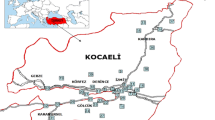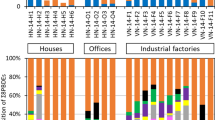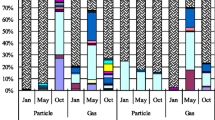Abstract
The health risks of polybrominated diphenyl ethers (PBDEs) to toddlers, children, and adults in creches, nursery schools, cars, and offices in Nsukka, Nigeria, via inhalation, ingestion, and dermal exposure pathways were evaluated. Eight PBDEs congeners (BDE-28, BDE-47, BDE-100, BDE-99, BDE-154, BDE-153, BDE-183, and BDE-209) were determined using gas chromatography-mass spectrometry. This is the first study on PBDEs in creches and nursery schools in Africa. The mean (median) ∑8PBDEs (ng/g) in creches, nursery schools, offices, and cars were 4355 (1850), 2095 (1130), and 37741 (2620) respectively. The concentrations of PBDEs between the three microenvironments were significantly different (p ˂ 0.05), and the highest concentration was found in cars. Ingestion of dust was the predominant pathway of exposure to PBDEs for toddlers and children, while dermal absorption was the dominant pathway for adults. Dermal absorption and ingestion in cars, creches, and nursery schools were of the same magnitude. Toddlers with the highest ingestion rate of PBDEs in creches, nursery schools, and cars are at risk especially from prolonged exposure.


Similar content being viewed by others
Data availability
The datasets used and/or analyzed during the current study are available from the corresponding author on reasonable request.
References
Abafe OA, Martincigh BS (2015) Polybrominated diphenyl ethers and polychlorinated biphenyls in indoor dust in Durban, South Africa. Indoor Air 25:547–556
Akortia E, Okonkwo JO, Lupankwa M, Osae SD, Daso AP, Olukunle OI, Chaudhary A (2016) A review of sources, levels, and toxicity of polybrominated diphenyl ethers (PBDEs) and their transformation and transport in various environmental compartments. Environ Rev 2016(24):253–273. https://doi.org/10.1139/er-2015-0081
Akortia E, Lupankwa M, Okonkwo JO (2019) Influence of particle size and total organic carbon on the distribution of polybrominated diphenyl ethers in landfill soils: assessment of exposure implications. J Anal Sci Technol 10:23. https://doi.org/10.1186/s40543-019-0182-4
Ali N, Eqani SAMAS, Ismail IMI, Malarvannan G, Kadi MW, Albar HMS, Rehan M, Covaci A (2016) Brominated and organophosphate flame retardants in indoor dust of Jeddah, Kingdom of Saudi Arabia: implications for Human Exposure. Sci Total Environ 569-570:269–277
Batterman SA, Chernyak S, Jia C, Godwin C, Charles S (2009) Concentrations and emissions of polybrominated diphenyl ethers from US houses and garages. Environ Sci Technol 43:2693–2700
Batterman S, Godwin C, Chernyak S, Jia C, Charles S (2010) Brominated flame retardants in offices in Michigan, U.S.A. Environ Int 36:548–556
Besis A, Christia C, Poma G, Covaci A, Samara C (2017) Legacy and novel brominated flame retardants in interior car dust – implications for human exposure. Environ Pollut 230:871–881
Bromine Science and Environmental Forum (BSEF) (2006) The European legislation on WEEE and ROHS in Brussels. Available online http://www.bsef.com/regulation/Europe/an-overview-of-european-legislation. Accessed 30th November, 2019.
Chen SJ, Ma YJ, Wang J, Chen D, Luo XJ, Mai BX (2009) Brominated flame retardants in children’s toys: concentration, composition and children‘s exposure and risk assessment. Environ Sci Technol 43:4200–4206
Civan MY, Kara UM (2016) Risk assessment of PBDEs and PAHs in house dust in Kocaeli, Turkey: levels and sources. Environ Sci Pollut Res 23:23369–23384
de Wit CA, Bjorklund JA, Thureson K (2012) Tri-decabrominated diphenyl ethers and hexabromocyclododecane in indoor air and dust from Stockholm micro environments 2: indoor sources and human exposure. Environ Int 39:141–147
Ding N, Wang T, Chen SJ, Yu M, Zhu ZC, Tian M, Luo XJ, Mai BX (2016) Brominated flame retardants (BFRs) in indoor and outdoor air in a community in Guangzhou, a megacity of southern China. Environ Pollut 212:457–463
Gou YY, Que DE, Chuang CY, Chao HR, Shy G, Hsu YC, Lin CW, Chuang KP, Tsai CC, Taya LL (2016) Dust levels of Polybrominated diphenyl ethers (PBDEs) and polybrominated dibenzo-p-dioxins/furans (PBDD/Fs) in the Taiwanese elementary school classrooms: assessment of the risk to school age children. Sci Total Environ 572:734–741
Guo J, Patton L, Wang J, Xu Z (2020) Fate and migration of polybrominated diphenyl ethers in a workshop for waste printed circuit board de-soldering. Environ Sci Pollut Res 27:30342–30351. https://doi.org/10.1007/s11356-019-06735-1
Harrad S, Abdallah MAE (2011) Brominated flame retardants in dust from UK cars:- within-vehicle spatial variability, evidence for degradation and exposure implications. Chemosphere. 82:1240–1245
Harrad S, Ibarra C, Abdallah MAE, Boon R, Neels H, Covaci A (2008) Concentrations of brominated flame retardants in dust from United Kingdom cars, homes, and offices: causes of variability and implications for human exposure. Environ Int 34:1170–1175
Harrad S, Abdallah MAE, Oluseyi T (2016) Polybrominated diphenyl ethers in cars, homes and offices in Lagos, Nigeria. Chemosphere 146:346–353
Hassan Y, Shoeib T (2015) Levels of polybrominated diphenyl ethers and novel flame retardants in microenvironment dust from Egypt: an assessment of human exposure. Sci Total Environ 505:47–55
Ibeto CN, Nkechi WC, Ekere NR (2019) Health risks of polychlorinated biphenyls (PCBs) levels in fish and sediment from River Niger (Onitsha Axis). J Aquat Food Product Technol 28(2):138–149. https://doi.org/10.1080/10498850.2019.1568332
Iwegbue CM, Eyengh SB, Egobueze FE, Odali EW, Tesi GO, Nwajei GE, Martincigh SB (2019) Polybrominated diphenyl ethers and polychlorinated biphenyls in indoor dust from electronic repair workshop in Southern Nigeria: implications for onsite human exposure. Sci Total Environ 671:914–927
Jans U (2016) Emerging brominated flame retardants in sediments and soils: a review. Curr Pollut Rep 2:213–223. https://doi.org/10.1007/s40726-016-0041-5
Jin MT, Li LJ, Zheng YX, Shen XY, Wang DR (2019) Polybrominated diphenyl ethers (PBDEs) in dust in typical indoor public places in Hangzhou: levels and an assessment of human exposure. Ecotoxicol Environ Saf 169:325–334
Kang Y, Wang HS, Cheung KC, Wong MH (2011) Polybrominated diphenyl ethers (PBDEs) in indoor dust and human hair. Atmos Environ 45:2386–2393
Kefeni KK, Okonkwo JO (2012) Analysis of major congeners of polybromobiphenyls and polybromodiphenyl ethers in office dust using high resolution gas chromatography-mass spectrometry. Chemosphere 87:1070–1075
Kim HH, Yang JY, Jang YS, Lee YJ, Lee CS, Shin DC (2011) Exposure assessment and health risk of polybrominated diphenyl ether (PBDE) flame retardants in indoor environments of children's facilities in Korea. Asian J Atmos Environ 5-4:247–262
Kofi ED, Adjei JK, Cann SK, Essel G, Osei-Fosu P (2018) Levels of polybrominated diphenyl ethers (PBDEs) in some Ghanaian water body environments. Res. J. Environ Sci 12:73–82
La Guardia MJ, Hale RC, Harvey E (2006) Detailed polybrominated diphenyl ethers (PBDE) congener composition of the widely used penta-, octa-, and deca-PBDE technical flame-retardant mixtures. Environ Sci Technol 40:6247–6254
Leonetti C, Butt CM, Hoffman K, Stapleton HM (2016) Concentrations of polybrominated diphenyl ethers (PBDEs) and 2,4,6-tribromophenol in human placental tissues. Environ Int 88:23–29. https://doi.org/10.1016/j.envint.2015.12.002
Li Y, Chen L, Ngoc DM, Duan Y-P, Lu Z-B, Wen Z-H et al (2015a) Polybrominated diphenyl ethers (PBDEs) in PM2.5, PM10, TSP and gas phase in office environment in Shanghai, China: occurrence and human exposure. PLoS One 10(3):e0119144. https://doi.org/10.1371/journal.pone.0119144
Li Y, Chen L, Wen ZH, Duan YP, Lu ZB, Meng XZ, Zhang W (2015b) Characterizing distribution, sources, and potential health risk of polybrominated diphenyl ethers (PBDEs) in office environment. Environ Pollut 198:25–31
Lucas D, Petty SM, Keen O, Luedeka B, Schlummer M, Weber R, Barlaz M, Yazdani R, Riise B, Rhodes J, Nightingale D, Diamond ML, Vijgen J, Lindeman A, Blum A, Koshland CP (2018) Methods of responsibly managing end-of-life foams and plastics containing flame retardants: part I. Environ Eng Sci 35(6):573–587. https://doi.org/10.1089/ees.2017.0147
Mandalakis M, Besis A, Stephanou EG (2009) Particle-size distribution and gas/particle partitioning of atmospheric polybrominated diphenyl ethers in urban areas of Greece. Environ Pollut 157:1227–1233
Martellini T, Diletti G, Scortichini G, Lolini M, Lanciotti E, Katsoyiannis A, Cincinelli A (2016) Occurrence of polybrominated diphenyl ethers (PBDEs) in foodstuffs in Italy and implications for human exposure. Food Chem Toxicol 89:32–38
Niu D, Qiu Y, Li L, Zhou Y, du X, Zhu Z, Chen L, Lin Z (2018) Occurrence of polybrominated diphenyl ethers in floor and elevated surface house dust from Shanghai, China. Environ Sci Pollut Res 25:18049–18058. https://doi.org/10.1007/s11356-018-1968-4
Niu D, Qiu Y, Du X et al (2019) Novel brominated flame retardants in house dust from Shanghai, China: levels, temporal variation and human exposure. Environ Sci Eur 31:6. https://doi.org/10.1186/s12302-019-0189-x
O'Driscoll K, Robinson J, Chiang WS, Chen YY, Kao RC, Doherty R (2016) The environmental fate of polybrominated diphenyl ethers (PBDEs) in western Taiwan and coastal waters: evaluation with a fugacity-based model. Environ Sci Pollut Res Int 23(13):13222–13234. https://doi.org/10.1007/s11356-016-6428-4
Ohajinwa CM, van Bodegou PM, Osinbajo O, Xie Q, Chen J, Vijver MG, Peijnenburg JGM (2019) Health risks of polybrominated diphenyl ethers (PBDEs) and metals at informal electronic waste recycling sites. Int J Environ Res Public Health 16:906
Olukunle OI, Okonkwo OJ, Sha’ato R, Wase GA (2015a) Levels of polybrominated diphenyl ethers in car dust in Nigeria: concentrations and implication for non-dietary human exposure. Microchem J 123:99–104
Olukunle OI, Okonkwo OJ, Sha’ato R, Wase GA (2015b) Levels of polybrominated diphenyl ethers in indoor dust and human exposure estimates from Makurdi, Nigeria. Ecotoxicol Environ Saf 120:394–399
Rayne S, Wan P, Ikonomou M (2006) Photochemistry of a major commercial polybrominated diphenyl ether flame retardant congener: 2,2 ′,4,4 ′,5,5 ′-hexabromodiphenyl ether (BDE153). Environ Int 32:575–585
Śmiełowska M, Zabiegała B (2018) Determination of polybrominated diphenyl ethers (PBDEs) in dust samples collected in air conditioning filters of different usage – method development. J Chromatogr A 1565(2018):57–67. https://doi.org/10.1016/j.chroma.2018.06.041
Soederstroem G, Sellstroem U, de Wit CA, Tysklind M (2004) Photolytic debromination of decabromodiphenyl ether (BDE 209). Environ Sci Technol 38:127–132
UNEP (2010) Technical review of the implications of recycling commercial penta and octabromodiphenyl ethers. Stockholm Convention document for 6th POP Reviewing Committee meeting. Available online: http://www.chm.pops.int/. Accessed 15th Nov. 2019.
USEPA (1997) Exposure Factors Handbook. National Center for Environmental Assessment, Office of Research and Development, EPA/600/P-95/002Fa ± c, Washington, DC
USEPA (2001) Risk Assessment Guidance for Superfund. Vol. 1: Human evaluation manual (part E, supplemental guidance for defined risk assessment). EPA/540/R/99/005.7. Office of Emergency and Remedial Response, USEPA, Washington, DC. Accessed 30th Oct. 2019
USEPA (2002) Child specific exposure factors handbook. EPA-600-P-00-002B. National Center for Environmental Assessment, Washington, DC [Online] https://cfpub.epa.gov/ncea/risk/recordisplay.cfm?deid=55145. Accessed 12th Nov., 2019
USEPA (2009) Polybrominated Diphenyl Ethers (PBDEs) Action Plan Summary. Available online: https://www.epa.gov/assessing-and-managingchemicals-under-tsca/polybrominated-diphenyl-ethers-pbdes-action-plan. Assessed 19 Oct 2019
USEPA (2010) An exposure assessment of polybrominated diphenyl ethers (PBDE). U.S. Environmental Protection Agency Washington, DC, EPA/600/R-08/086F
Vuong AM, Yolton K, Dietrich KN, Braun JM, Lanphear BP, Chen A (2018) Exposure to polybrominated diphenyl ethers (PBDEs) and child behavior: current findings and future directions. Horm Behav 101:94–104. https://doi.org/10.1016/j.yhbeh.2017.11.008
Wang R, Tang T, Xie J, Tao X, Huang K, Zou M et al. (2018) Debromination of polybrominated diphenyl ethers (PBDEs) and their conversion to polybrominated dibenzofurans (PBDFs) by UV light: Mechanisms and pathways. J Hazard Mater 354:1–7
Ward MH, Colt JS, Deziel NC, Whitehead TP, Reynolds P, Gunier RB, Nishioka M, Dahl GV, Rappaport SM, Buffler PA, Metayer C (2014) Residential levels of polybrominated diphenyl ethers and risk of childhood acute lymphoblastic leukemia in California. Environ Health Perspect 122(10):1110–1116
Xiang L, Hongli L, Xiaoshan J, Guiying L, Taicheng A, Yanpeng G (2018) Novel approach for removing brominated flame retardant from aquatic environments using Cu/Fe-based metal-organic frameworks: a case of hexabromocyclododecane. Sci Total Environ 621:1533–1541
Xie X, Qian Y, Wu Y, Yin J, Zhai J (2012) Effects of decabromodiphenyl ether (BDE 209) on the avoidance response, survival, growth and reproduction of earthworms (Eisenia fetida). Ecotoxicol Environ Saf 90:21–27
Zhong Y, Li D, Zhu X, Huang W, Peng P (2018) Solvent effects on quantitative analysis of brominated flame retardants with Soxhlet extraction. Environ Geochem Health 40:1955–1964
Acknowledgments
The authors are grateful to the National Centre for Energy Research and Development (NCERD), University of Nigeria, Nsukka for the use of their facilities. Also, technical assistance by the laboratory staff of CTX-ION Analytics is hereby acknowledged.
Author information
Authors and Affiliations
Contributions
CNI designed the study, carried out statistical analysis, was involved in writing the manuscript, and supervised the project. EA carried out experimental studies and was also involved in writing of the manuscript. BI and DO were both involved in the experimental studies. All authors read and approved the final manuscript.
Corresponding author
Ethics declarations
Ethics approval and consent to participate
Not applicable.
Consent for publication
Not applicable.
Competing interests
The authors declare no competing interests.
Additional information
Responsible editor: Lotfi Aleya
Publisher’s note
Springer Nature remains neutral with regard to jurisdictional claims in published maps and institutional affiliations.
Supplementary Information
ESM 1
(DOCX 81.2 kb)
Rights and permissions
About this article
Cite this article
Ibeto, C., Aju, E., Imafidon, B. et al. Exposure evaluation and risk assessment of polybrominated diphenyl ethers in dust from microenvironments in Nsukka, Nigeria. Environ Sci Pollut Res 28, 32374–32385 (2021). https://doi.org/10.1007/s11356-021-13054-x
Received:
Accepted:
Published:
Issue Date:
DOI: https://doi.org/10.1007/s11356-021-13054-x




